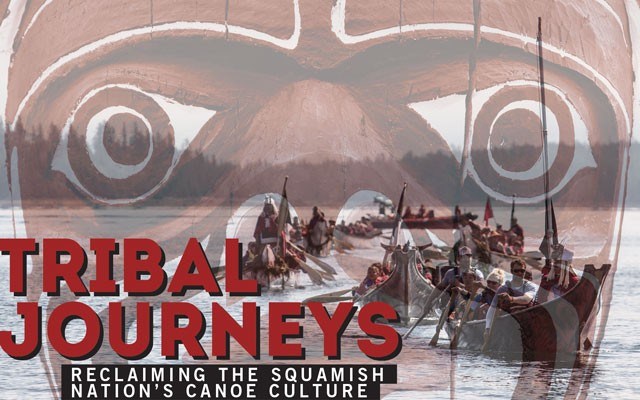Picking up speed, two dugout canoes sliced through the water past the log sort on the Mamquam Blind Channel in Squamish and into Howe Sound. It was the start of an adventure of a lifetime.
Twenty-five young members of the Squamish Nation, from reserves in and around Squamish and North and West Vancouver, had spent the previous night camping in a field adjacent to the ocean. There had been a feast at Totem Hall on the Stawamus reserve and in the morning parents and community members were turning up before the young canoeists had packed away their tents.
Loved ones handed them double-doubles from Tim Horton's and when they'd had a little caffeine in their systems and sunlight in their eyes, they were ready to carry the huge, heavy canoes their carvers had made to the launch site.
The tide was out and it was slippery, one or two slid and fell on exposed seaweed. It was a nerve-wracking moment until the canoes were placed tenderly in the Mamquam.
One mother, moved to tears, made a short speech in the Skwxwú7mesh language and told them it was in honour of their journey.
Then they hit the watery highway at the start of Tribal Journeys 2014. The date was Thursday, June 26.
The Heiltsuk First Nation to the north had put out a call to other "Canoe Nations" from Alaska to Oregon, inviting dozens of indigenous communities to take to the Pacific and make their way to the village of Bella Bella, population 1,400, on the central British Columbian Coast.
The youth of each nation were expected to use the traditional watercraft methods of their communities to make the journey. At the end of it all, the Heiltsuk held a Qatuwas or "People Gathering Together Festival" from July 13 to 18. The response this year was great. Dozens of canoes eventually arrived in Bella Bella with over 1,000 "pullers" (as the canoeists are called), while about 5,000 other visitors reached the village overland. Some participants travelled on their own paddle power for weeks to get there.
Allowing for bad weather and rest days, it took Squamish Nation participants three weeks. They ranged in age from 11-year-old children to young adults in their 30s. The youngest participated for only part of the journey, around a week.
These are some of their stories.
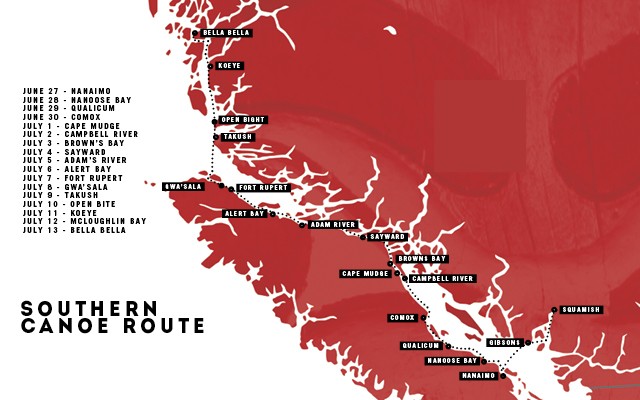
Route.
Getting organized
A resident of the Capilano Reserve in West Vancouver, Dustin Rivers is the 25-year-old organizer of this year's journey. Also known as Khelsilem in his language, he spent around a year, with help, organizing and fundraising. At the start of the journey, Rivers said, supporters were on hand with vehicles to move the heaviest gear, though they couldn't be in locations without roads. There was also a support boat on hand in case of problems.
"We started planning for this trip in 2013. The first thing was thinking about logistics. Once the dates were announced, we could estimate what date we would need to leave. We estimated 21 days and that is close to what it ended up being.
"It is up to your group to set your rules and create the environment you travel with, the main motivations for doing the trip. It can vary widely between canoe families. The whole reason Tribal Journeys was started was out of a vision that a man from Bella Bella had, gathering all the canoes together and revitalizing our traditional canoe-building cultures, reconnecting people to the land and the water, and doing it in a drug- and alcohol-free way. That has been a guiding principle.
"For us, it was interesting. We had a lot of young people in our canoe family. Some of them have different lifestyles outside the cultural journey and maybe they do participate in drugs and alcohol in their own time, but they actually took the time to say they were going to stop while on the journey. For some teenagers, when they have the opportunity to stay home for the summer and party, for them to say 'No, I don't want to do that; I want to go on a canoe journey,' it is a huge thing. And not just for them...
"Our feeling as a community has come a long way. Drugs and alcohol is becoming less of a systemic problem among our young people and our young people are becoming stronger and healthier in their choices. The revitalization of a lot of our culture has really taken place in the last two decades.
"I really feel that when the Tribal Journeys started that is where it came from because it was the event that brought everything together. It was about being on the water, the traditions on the water, about learning our songs and our history, our protocols and teachings of how to live together. We learned about our regalia and our traditional crafts, like weaving. It brought out our carving and different carving techniques, for paddle making. All those kinds of things, all together at once.
"For most of this trip, the singers for our canoe family were the young people. Almost everybody was under the age of 25. When you are travelling on the water and visiting other communities (the canoes would stay at different reserves each night on the journey north) you hear the songs of other places. We say that songs come from the land, and you can really hear it. When you travel to a different community you hear a song sound a little different.
"It's an experience for our young people to witness and be a part of. It stays with them for the rest of their lives. It helps them realize what we have as a people and what other people have, and also what we do not have... They make those comparisons and they see how gifted they are or how much work needs to be done. Either way, it's a true blessing for our young people, who are going to lead our Nation."
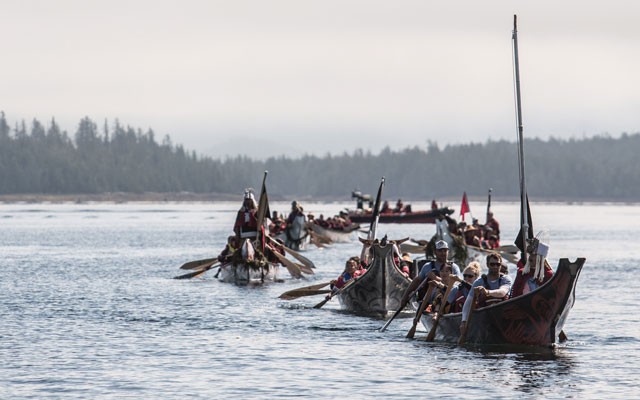
PHOTO BY KRIS KRUG / KRISKRUG.COM - From here to Bella Bella Two Squamish Nation dugout canoes, filled with young people on a cultural quest, took an epic journey up the British Columbian coast.
The great crossing
"Man, that crossing over from the Mainland to Nanaimo (on Vancouver Island) was one of the hardest stretches. No matter what time you go, you never go with the tide. It's always coming at you sideways, either way. You can hit slack tide for a few hours but after that it gets moving and it moves pretty quick. You have the whole Salish Sea draining out south and then coming in from the north.
"We came out Gibsons on the second day out from Squamish and it was windy. The winds were 20 or 25 knots. We got out there, and the winds hit maybe three or five kilometres off the Sunshine Coast and it didn't let up. We canoed up the coast a little and got as far as Roberts Creek.
"With our ancestors, if it got too rough they would not push it. All they had to do was go into shore, flip the canoe over, start a fire and wait for the weather to change. You could wait one day or two days... there was no rush. Whereas because we were on the set schedule, we were operating on modern terms. We pulled in, waited a day and tried an earlier start. We started at 5 a.m. and got out for an hour and it started picking up right away again. We were surprised.
"We canoed north past Sechelt, and the wind didn't let up all that day, but by 6 p.m. it was like glass all the way across. So we started gunning it across (the crossing at that point is around 40 kilometres to Vancouver Island) and we went as fast as we could, but we ended up getting towed after a while because it started getting dark. It was nice and a full moon with stars, and we pulled into Nanoose Bay around 12:30 a.m.
"The same thing happened when we tried to cross back to the mainland. We were weathered in at Port Hardy for three days because there were 20–30-knot winds on the open ocean. It was funny that it wasn't raining. That would have been nice. The rain would have calmed the wind down."
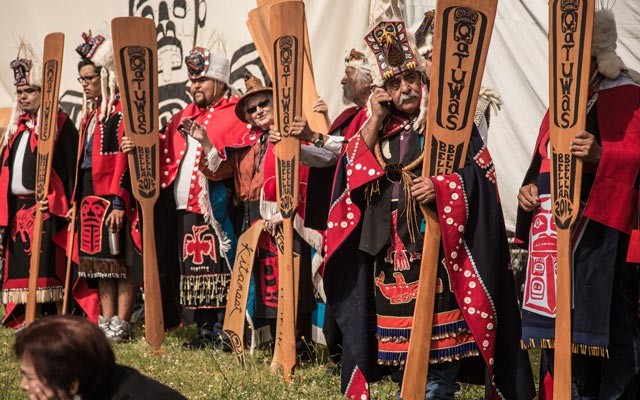
PHOTOS BY KRIS KRUG / KRISKRUG.COM - Bella Bella welcoming the canoe nations as part of Tribal Journeys 2014.
A mother and child's journey
Joyce Williams, 33, was one of two mothers with toddlers who participated in the Tribal Journeys. She brought her three-year-old daughter Josephine. She explained that the children were not in the canoes, instead travelling with the support vehicles, with herself and the other Mom taking turns each day to watch the girls.
"It was definitely challenging to bring Josephine, but when I realized I would be taking the journey, bringing my daughter was something I really wanted to make happen. This is my first Tribal Journey... getting her to experience different aspects of it at such a young age was super special for her.
"I told her that we were going to go camping and going on the boat. She would go on the ferries, but she didn't actually come in the canoe with me but I would see her at the end of each day. We were lucky enough that me and Megan (the other Mom) go to the same family program, and her daughter was in the car so she had a little buddy to hang out with.
"They were so cute. In the car they would sing one of our Nation's Welcome Songs... and there they were, they knew all the words. They were singing in tune one of our traditional songs. It was just amazing. We tried to record it but they weren't cooperating at all!
"I think hearing so much singing along the journey and so much cultural sharing, they were getting right into it. There was so much sharing going on. Just that daily dose of the culture was fantastic for Josephine.
"It's hard to say in words how it impacted me. It was a real challenge, but there were definitely lessons learned and we really worked together as a team. The people I went with became my family; we worked in our different roles in the team. I knew most of the people who were there with us but I also met some family (members) for the first time, a cousin I'd never seen before. We got to know each other really well.
"We were camped in Sayward (on the northern tip of Vancouver Island) for two days and there was a lady who asked how many times I had been on the journey (some participants have been several times). I told her it was my first year and she asked, 'How old are you?' And I told her and she asked what took me so long! For a minute, I was, like, 'Uhhh... I don't know!'
"It got me to thinking about why it had taken me this long. I think the initiative wasn't there. Now that I've got a daughter, I've got different life views, for sure. There are different teachers that I want her to know and be involved in. Since I was five, I have been involved with the drumming and singing aspect of our culture, but being a part of a trip by ocean-going canoes, a super huge part of our history as a people, going back to that travel and that way of life was certainly a huge experience.
"I took so much pride in it. And with social media, everybody was sharing pictures and our stories of what was happening. Everybody was so engaged with the journey and more people want to take part. It's definitely growing in our community, especially with our youth."
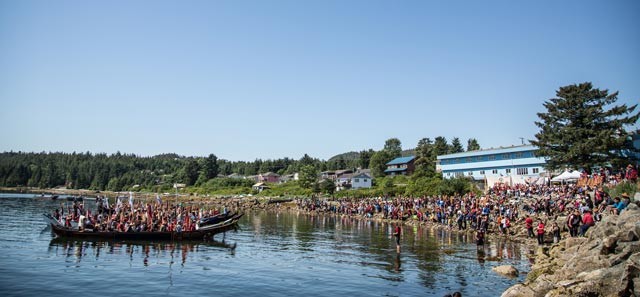
PHOTOS BY KRIS KRUG / KRISKRUG.COM - Bella Bella welcoming the canoe nations as part of Tribal Journeys 2014.
Defining the cultural impact
At 19, Swo-Wo Gabriel has already spent several years acting (he recently brought home a Leo Award for his work on the TV series Blackstone), and he is a cultural ambassador at the Squamish Lil'wat Cultural Centre in Whistler, often participating in drumming and singing performances. For Gabriel, on his first Tribal Journey, the experience was all about how his Nation and the other Nations expressed themselves.
"Because of how different all of the coastal people are, all across B.C. — and there were a few from America — knowing your culture, the songs, how your people dressed and paddling a traditional Squamish canoe, gave me a huge, huge sense of pride. It shows who you are. It's not only being proud of being First Nations, it's being proud of being Squamish, knowing where your roots came from and practicing them.
"On the journey, it really opened my eyes to how specific the culture I know is, compared to the rest of the cultures around B.C. I know a lot of the Squamish and Lil'wat culture; I know tons of our songs. But going on the Tribal Journeys, I was hearing other cultures' songs for the first time. It shows how big the picture is. The languages change.
"Every place we'd go to, we'd pull into the territory and there would be people there waiting for us and we'd be welcomed in. They would speak their traditional language and do their welcoming. It was all so different from what I'd experienced before.
"The journey connected really, really well with what I've done before. It's one thing to read about your culture; it's another thing to practice it. I've really wanted to do Tribal Journeys for a long time.
"To hear how different all the songs are... even just the way they reflect our languages. You can really tell when a song is Coast Salish (the network of Nations in southern B.C. along the Pacific coast) and our area, and you can tell when a song is from the Kwakwaka'wakw people (the network of First Nations communities to the north). The people from Oregon, I'd never heard songs like theirs before.
"There would be set times for singing songs, but sometimes it would be 6 a.m. and we're all lined up for breakfast and some random guy in the line would start singing a song as we're waiting for food. That is totally normal on canoe journeys. Everyone listened to him.
"The canoes that we went in, I helped carve one of them (overall, there are seven different types of canoes in Squamish Nation culture, each performing a different task such as travelling or hunting). The canoe's name is Sialem, which was the name of the Son of the Sun. The Sun in the sky. We travelled in Sialem, he was blessed four days before the journey. This canoe was carved for Bella Bella.
"It was awesome to be able to go and be in a canoe I helped carve. People would ask about it. We have this Squamish tradition that if you want to be a canoe carver you have to carve a canoe before you turn 21. Long ago, if you started to learn canoe carving after 21 it's not really practical. You're pretty old. So I've done it!
"This past year, since I graduated (from Howe Sound Secondary School in Squamish) all these doors are opening up to me and it's really amazing. This journey was a big part of it. A whole half a summer and it was definitely worth it and I am looking forward to going on many more canoe journeys."
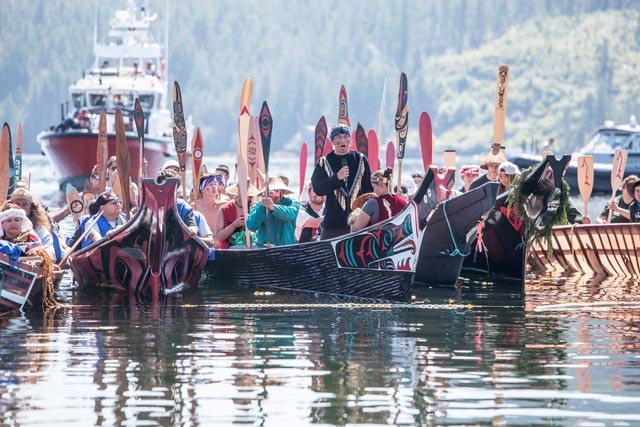
PHOTO BY KRIS KRUG / KRISKRUG.COM - Squamish canoes, with organizer Dustin Rivers (standing) at Bella Bella.
Bella Bella generosity
Dustin Rivers talks about the end of the journey in Bella Bella with the Heiltsuk Nation.
The Heiltsuk are credited with inspiring the revival of ocean-going travel for indigenous people in this part of the world. Traditional canoeing, as with so many other aspects of First Nations culture, had been suppressed for decades.
In recent times, the Heiltsuk carved a canoe and paddles and travelled from Bella Bella to Vancouver for Expo 86. They also participated in the "Paddle to Seattle" that year and again in 1989. Then, to commemorate the United Nations Year of Indigenous Peoples in 1993, the Heiltsuk held the first Qatuwas at Bella Bella. Tribal Journeys by canoe have happened each year since in different locations, with the Squamish Nation hosting one in 2001.
The 2014 event in Bella Bella was to commemorate the first, 21 years ago, with the journeys now becoming an essential annual expedition in coastal First Nations' culture.
"When we got to Bella Bella, one of our friends from the community said we could stay with him. He told us he had a place set up for us. It's a small community and there isn't a lot of space to camp. We got there and we couldn't reach him, but one of the other locals helped us. They brought up our gear because none of our vehicles got to Bella Bella, it was too expensive.
"We got to this house and were told this was where we were staying and there was a man I didn't know standing there.... He said, 'This is your place for the rest of your trip here. Use whatever you need to use and move whatever you need to move. The house is yours.'
"The whole week we stayed in this house, 25 of us staying in one house. Not only did we completely take over their living room and their bathroom and their laundry room, every morning they had breakfast for us, they had dinner for us. This was on top of the Bella Bella organizers hosting meals for everyone. They were just so generous and so open with us. Those types of traditions, the ethics and philosophy, were the most important part of the culture for me. We need to practice and live that with each other.

